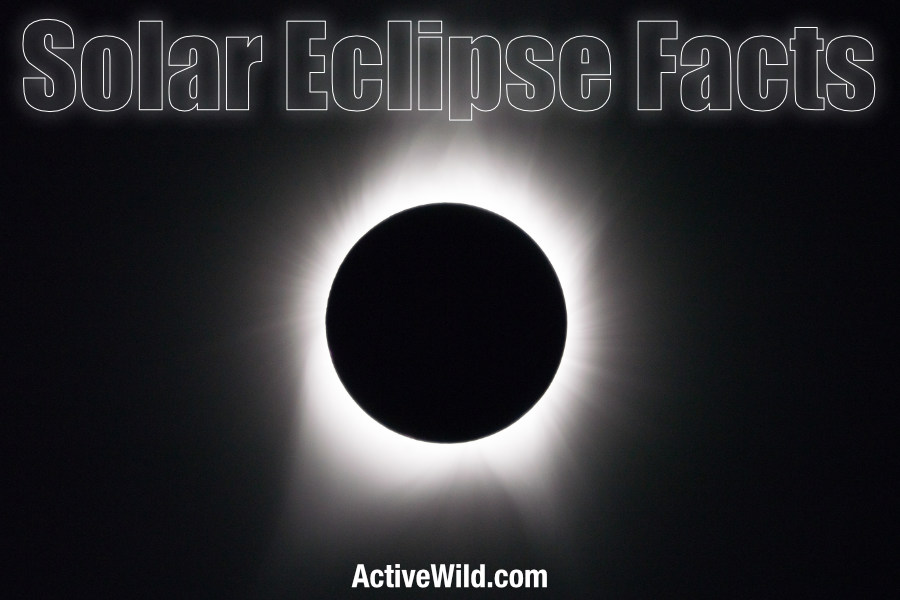What is a solar eclipse? On this page, you’ll discover what causes a solar eclipse, how often solar eclipses occur, and the different types of solar eclipse.
You’ll also find out about umbras, coronas, Bailey’s beads, the difference between partial and total eclipses, paths of totality, annular eclipses, and more.
Get the complete lowdown on solar eclipses in preparation for the total eclipse that will be seen in many parts of North America on Monday, April 8, 2024!
You can download a free printable question sheet for this page here.
Page Index
You can read the whole page to become a solar eclipse expert, or use the quick links below to find the facts you need.
What Is A Solar Eclipse? Definition
A solar eclipse is a natural phenomenon that occurs when the moon’s orbit around Earth brings it directly between Earth and the sun, blocking all or part of the Sun’s light from reaching parts of the Earth’s surface.
In a total solar eclipse, the Moon completely covers the Sun, causing a period of darkness for observers on Earth located within the moon’s shadow.
Care must be taken when viewing a solar eclipse. Looking directly at the sun without using appropriate viewing equipment can cause permanent eye damage.
Partial Vs Total Solar Eclipse
There are two main types of solar eclipse: partial solar eclipse and the more dramatic total solar eclipse. Let’s find out the differences between them …
Partial Solar Eclipse
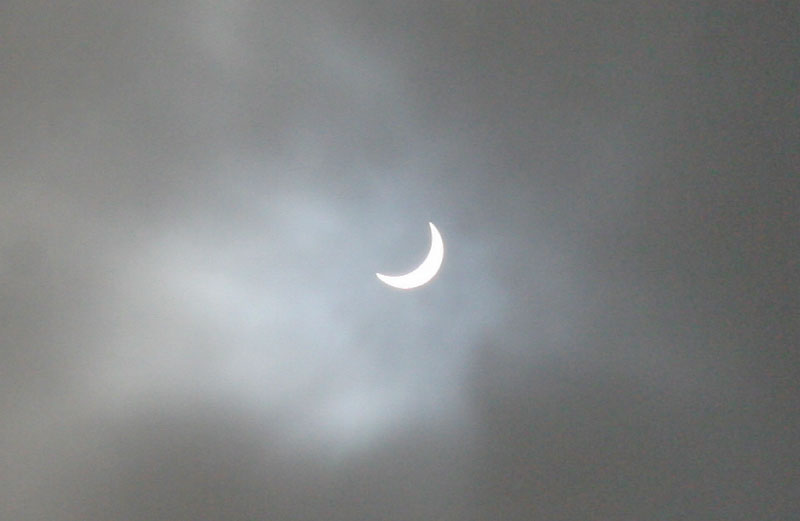
In a partial solar eclipse, the sun is only partially covered by the moon.
An observer will see the dark disk of the moon slowly pass in front of the sun. The sun will remain partially visible as a crescent shape in the sky.
Partial solar eclipses last much longer than total solar eclipses, and can be seen over a far greater area.
Total Solar Eclipse
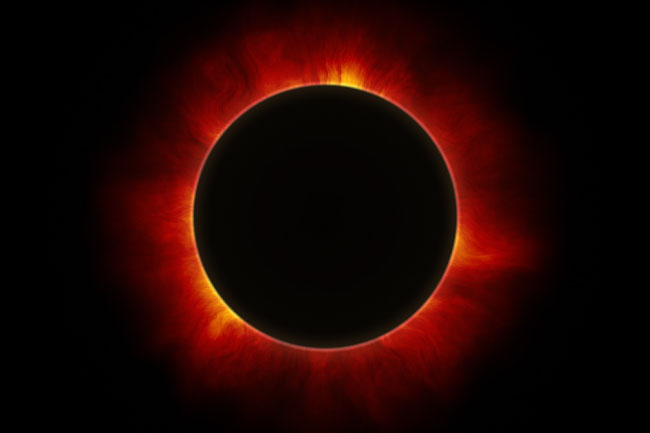
During a total solar eclipse, the sun is completely covered by the moon.
Observers will first see a partial eclipse as the moon begins to pass in front of the sun. The moon will then proceed to completely cover the sun, at which point the total eclipse begins.
The period during which the sun is completely obscured by the moon is known as ‘totality’. Totality usually only lasts for a few minutes. The maximum possible length of totality is 7 minutes and 32 seconds.
During totality, the moon prevents sunlight from reaching Earth. The skies darken, and day appears to turn into night.
After this brief period of darkness, the sun is revealed again as the moon continues on its journey, causing another period of partial eclipse. The eclipse ends when the moon has completely passed across the sun.
Only observers within the moon’s shadow will experience the eclipse. For everyone else, the sun will appear as normal.
What’s a Solar Eclipse: Eclipse Effects
Corona
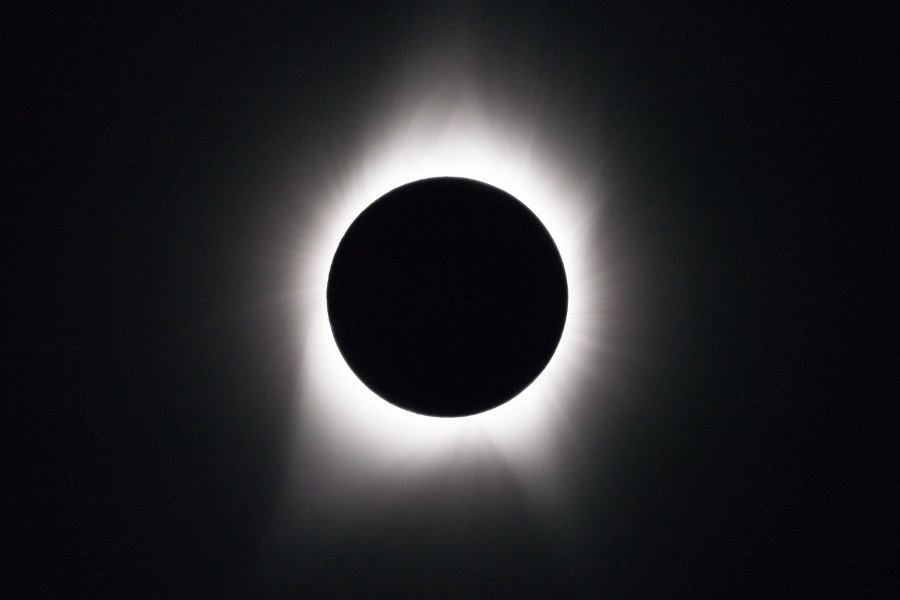
The corona is the outermost layer of the sun’s atmosphere. It is usually hidden by the light of the sun, but during an eclipse it appears as a glowing halo around the sun.
Bailey’s Beads
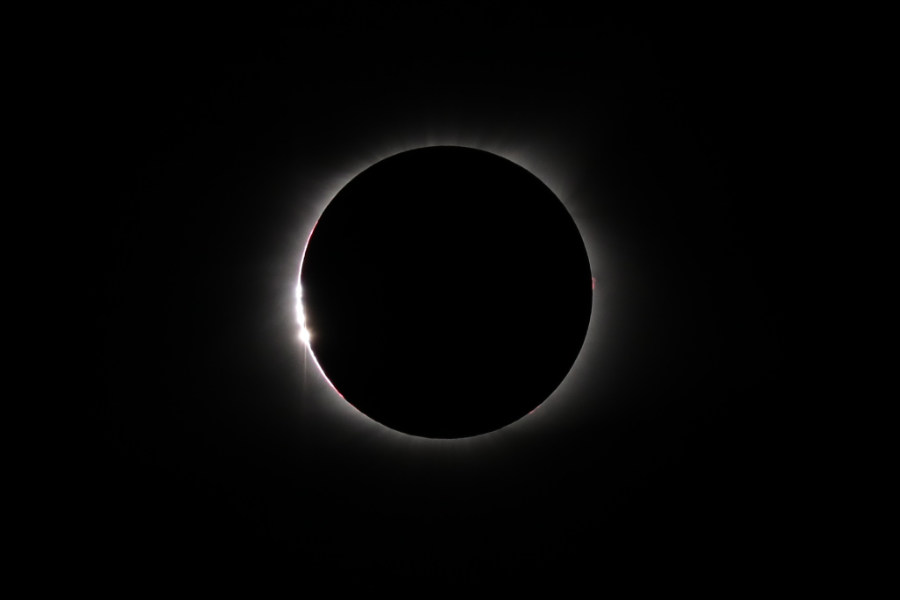
At the very beginning or end of a total solar eclipse, when the sun is almost completely hidden by the moon, an observer might see beads of light on the side of the moon.
These are known as ‘Baily’s beads’, and are caused by sunlight shining between mountains or other features on the moon’s surface.

Bailey’s beads are named after English astronomer Francis Baily, who explained the phenomenon after observing an annular eclipse in 1836. (You’ll find out what an annular eclipse is further down the page.)
When just a single, large bead of light is visible, the effect is known as a ‘Diamond ring’.
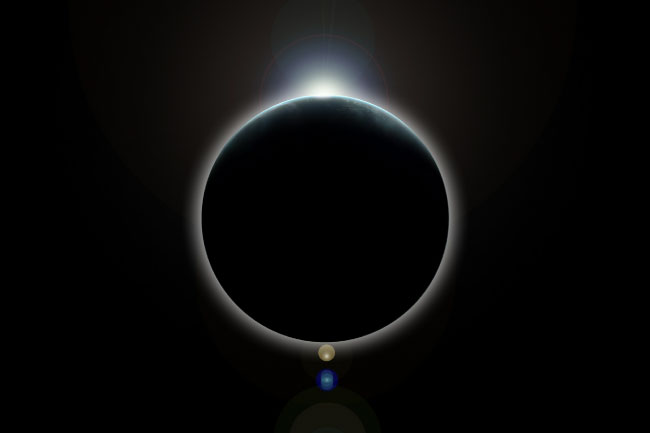
How does the moon cover the whole of the sun in a total eclipse?
You may be wondering how the relatively tiny moon manages to completely cover the much larger sun. The answer lies, of course, in their relative distances from Earth.
Although the moon is 400 times smaller than the sun, it is 390 times closer to Earth.
In the same way that you can seemingly cover a distant mountain with your thumb, the much smaller moon appears to completely cover the sun. (In other words, the apparent size of the two bodies is the same.)
The video below shows a scale model of the solar system being built:
Umbra & Penumbra
In a solar eclipse, the moon makes two types of shadow: an umbra and a penumbra.
The darkest part of the shadow cast by an astronomical body (i.e. a moon, planet, comet, etc.) onto another is known as the umbra. In a solar eclipse, the umbra is the shadow that appears on Earth when the moon is completely covering the sun.
In a partial eclipse, the sun is only partially covered. Some sunlight will be prevented from reaching Earth, but not all. This creates an area an area of half-shadow on Earth known as a penumbra.
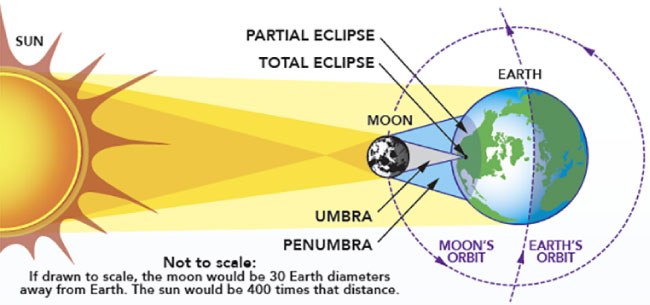
The amount of the sun being covered is known as the ‘magnitude’ of the eclipse (the more of the sun is being covered, the larger the eclipse’s magnitude). Magnitude decreases the further you are from the path of totality (see below).
- The umbra is the shadow caused by the moon as it covers the sun. If you’re inside the umbra, you’ll be experiencing a total solar eclipse.
- The penumbra is the shadow caused by the moon as it partially blocks the sun. If you’re inside the penumbra, you’ll be experiencing a partial solar eclipse. The further away you are from the umbra, the less of the sun is covered, and the lighter the penumbra.
The penumbra is way larger than the umbra. At any given time during an eclipse, the umbra may cover an area 100–160 km (62 to 99 mi) in diameter, whereas the penumbra might cover an area over 6,400 km (3,974 mi) in diameter.
During the course of an entire eclipse, only viewers situated within the narrow path of totality (see below) will experience a total solar eclipse. The total area covered by the penumbra during an eclipse can take in an entire continent.
What Is A Solar Eclipse: Path Of Totality
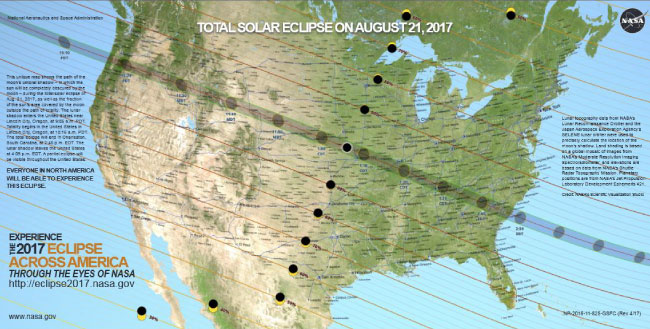
During a total solar eclipse, the moon’s shadow (its umbra) races across the surface of the Earth. The path that this shadow takes is called the path of totality. Anyone within the path of totality will experience a total eclipse.
The width of the path of totality isn’t the same for every eclipse. This is because the moon isn’t always the same distance from Earth. If a solar eclipse occurs when the moon is at its nearest point to Earth, then the path of totality can be a maximum of 267 km (166 mi) wide.
The path of totality is typically 100–160 km (62 to 99 mi) wide.
Only those observing from within the path of totality will witness a total solar eclipse.
Annular Eclipses

An annular eclipse occurs when the moon’s apparent size isn’t big enough to completely cover the sun, and the sun can still be seen behind the moon. In an annular eclipse, the sun looks like a ring around the dark circle of the moon, hence the name (annular means ‘ring-shaped’).
Annular eclipses can last for over 12 minutes.
You may be wondering why the moon is sometimes big enough to cover the sun, but at other times it’s too small. Let’s find out …
Elliptical Orbits
The moon doesn’t orbit Earth in a perfect circle. In fact, the path that it takes looks like a circle that has been stretched. This shape is called an ellipse, and the moon’s orbit is said to be ‘elliptical’.

Therefore, the moon is not always the same distance from Earth. Sometimes the moon can be too far away from Earth to completely obscure the Sun. This causes an annular solar eclipse.
The Earth’s orbit around the sun is also elliptical rather than circular, and the distance between Earth and the sun is therefore not always the same. Sometimes the sun is too close to be completely obscured by the moon.
The moon is very gradually moving further away from Earth. In the distant future, all solar eclipses will be annular, because the moon will be too far away to obscure the entire sun.
Hybrid Eclipses
A fourth type of solar eclipse, known as a hybrid eclipse, occurs when a total eclipse turns into an annular eclipse (or vice versa) in the same eclipse.
A hybrid eclipse is the least frequent type of eclipse to occur.
How long does a solar eclipse last?
Totality typically lasts for no more than a few minutes. If you’re watching a solar eclipse, the duration of totality is the time it takes for the moon’s umbra to pass over your position.
Mathematically, the maximum possible duration of totality is 7 min 32s. You’ll have to wait a long time for an eclipse to last anywhere near that long; from now to the year 8000, the longest-lasting total eclipse will be 7m 29s. It will occur in 2186.
The duration of an eclipse at any point on Earth is determined both by the size of the moon’s shadow at that point, and how fast the shadow is moving at that point.
The main factors that determine the umbra’s size and speed are the distance of the moon from Earth (the shorter this distance, the longer the eclipse); the distance of Earth from the sun (the further this distance, the longer the eclipse); and the position on Earth at which the eclipse occurs (the nearer the Equator, the longer the eclipse).
(Remember, the orbits of both Earth round the sun, and the moon round Earth, are elliptical. Therefore, the distances between all three objects are continually changing.)
Why can’t everyone on Earth see a solar eclipse?
The sun is very much bigger than the moon. Although the moon is much closer, it’s only just big enough to cover the sun. The moon will only appear to be covering the sun from a relatively small viewing area on Earth. (As we saw above, this area is typically 100–160 km (62 to 99 mi) wide.)
If you move outside of the line of totality during a total eclipse then you’ll be able to see the sun poking out from behind the moon. (You’ll now be watching a partial eclipse.)
The further you move away from the path of totality, the less of the sun will be covered, until eventually you’ll have moved outside of the eclipse altogether. (That might require a walk of over 2,000 miles, so be sure to wear some good boots.)
What Is A Solar Eclipse: Syzygy

A solar eclipse occurs when the sun, the moon and the Earth are aligned in a straight line, in that order. This can only occur during a new moon; that is, when the moon lies between the Sun and Earth.
(Normally a new moon can’t be seen, as it’s between the viewer on Earth and the sun.)
When three celestial bodies are aligned in a straight line they are said to be “in syzygy”. It’s a great word that might one day win you a game of Scrabble.
How often do solar eclipses occur?
There are usually 2 solar eclipses every year, but there can be a maximum of five – although this is an extremely rare occurrence.
Although it takes the moon just 27.3 days to orbit the Earth, there isn’t a solar eclipse every new moon. This is because the moon orbits Earth at a slight angle, which means that its shadow would usually be too far either above or below Earth.
Why are solar eclipses so rare?
During a solar eclipse, the moon’s umbra (shadow) only covers a tiny proportion (less than half a percent) of the Earth’s surface. Because around 70% of Earth is covered by water, it’s rare to see a total eclipse on land.
This is why a total eclipse is such a big deal: it’s not often one can be seen from an inhabited part of the world!
What’s the difference between a solar eclipse and a lunar eclipse?
As we’ve found out above, a solar eclipse occurs when the moon comes between the sun and Earth, and the three bodies are aligned (in syzygy). The resultant eclipse is caused by the moon’s shadow being projected onto the surface of the Earth.
The difference between a solar eclipse and a lunar eclipse is that during a lunar eclipse it’s the Earth that comes between the sun and the moon.
In a lunar eclipse Earth prevents the sun’s light from directly reaching the moon, and the moon is covered by the Earth’s shadow. The moon is only visible due to light that has been refracted (i.e. its direction has been changed) by the Earth’s atmosphere.
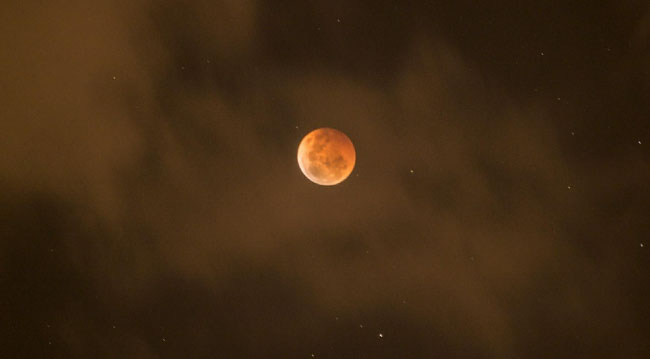
You can read about a lunar eclipse that occurred in England in 2015 here.
What Is A Solar Eclipse: Conclusion
We hope that you have enjoyed learning about what happens during a solar eclipse. You can read a report of what happened during a solar eclipse here: Solar Eclipse Report
On Monday, August 21, 2017, a total solar eclipse was visible in many parts of the United States. You can see a complete guide on this eclipse here: Total Solar Eclipse 2017 Viewing Guide

